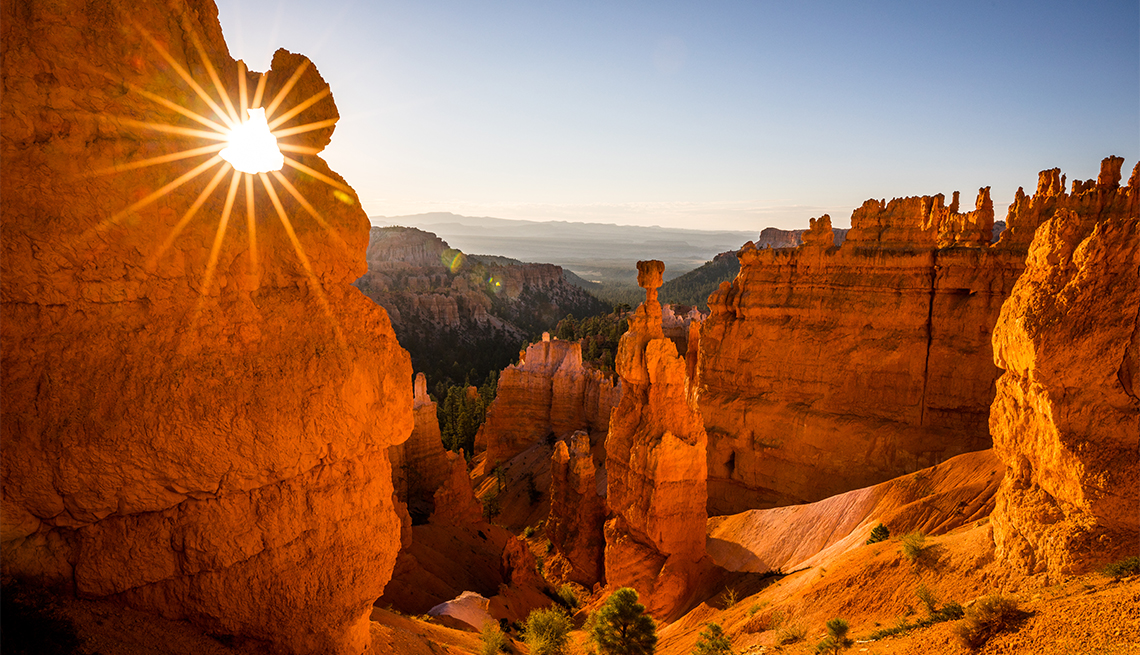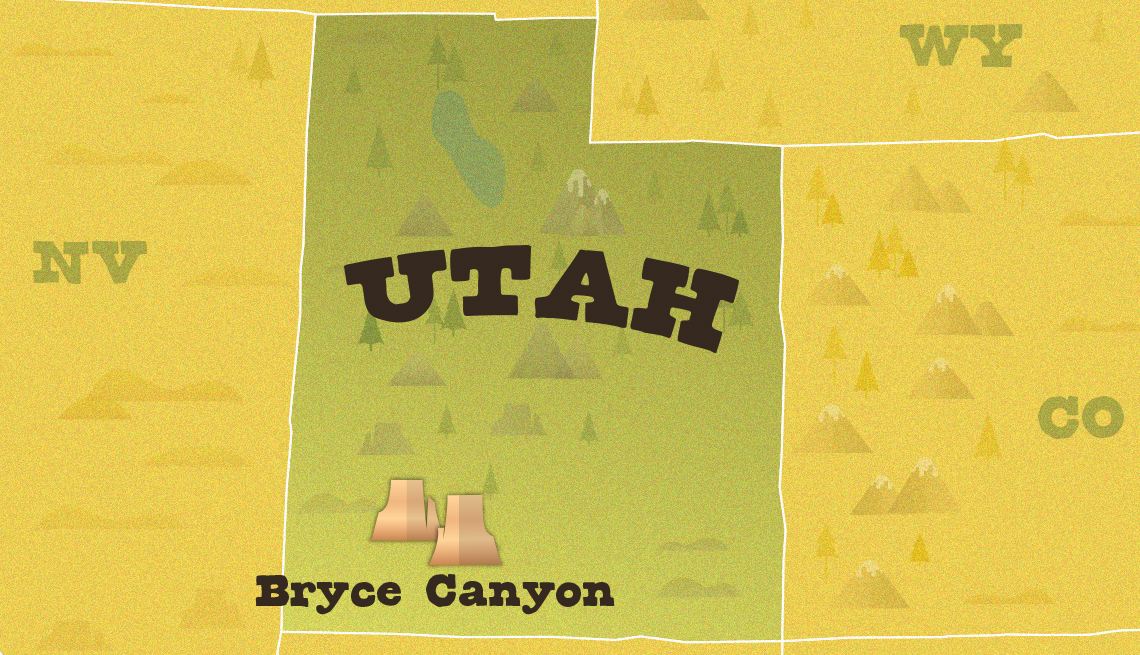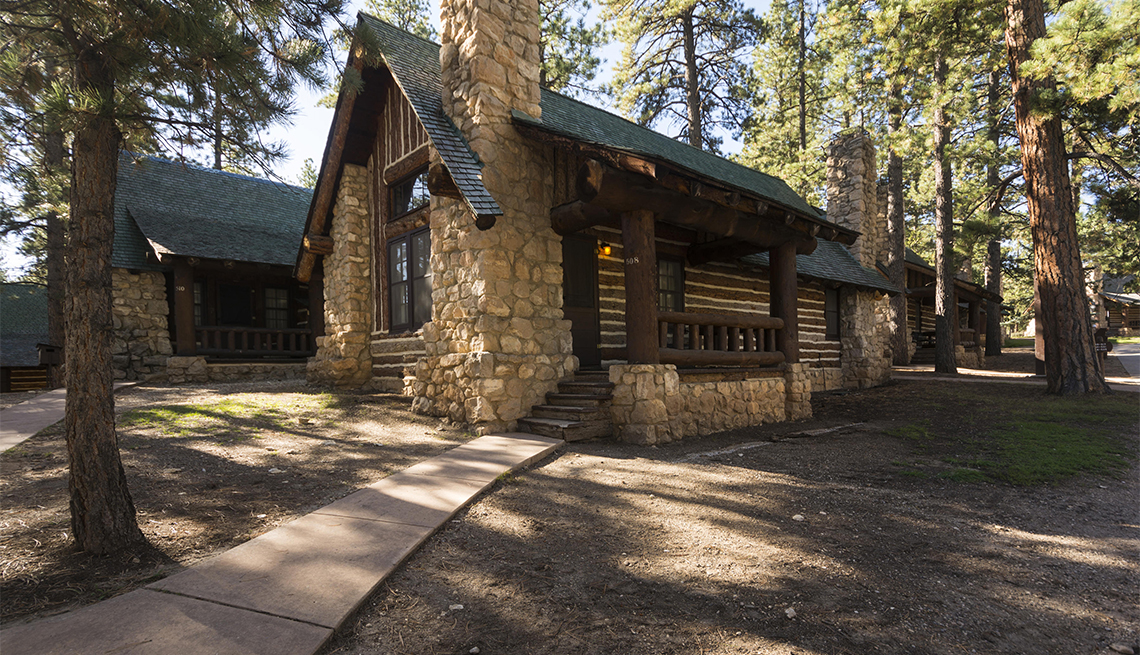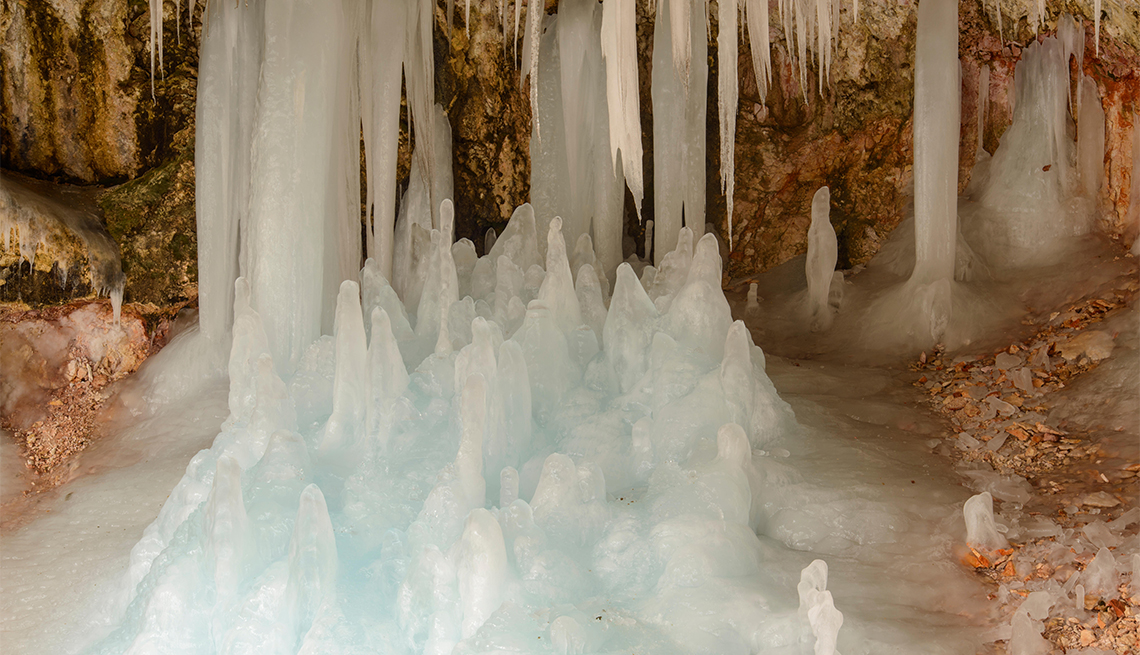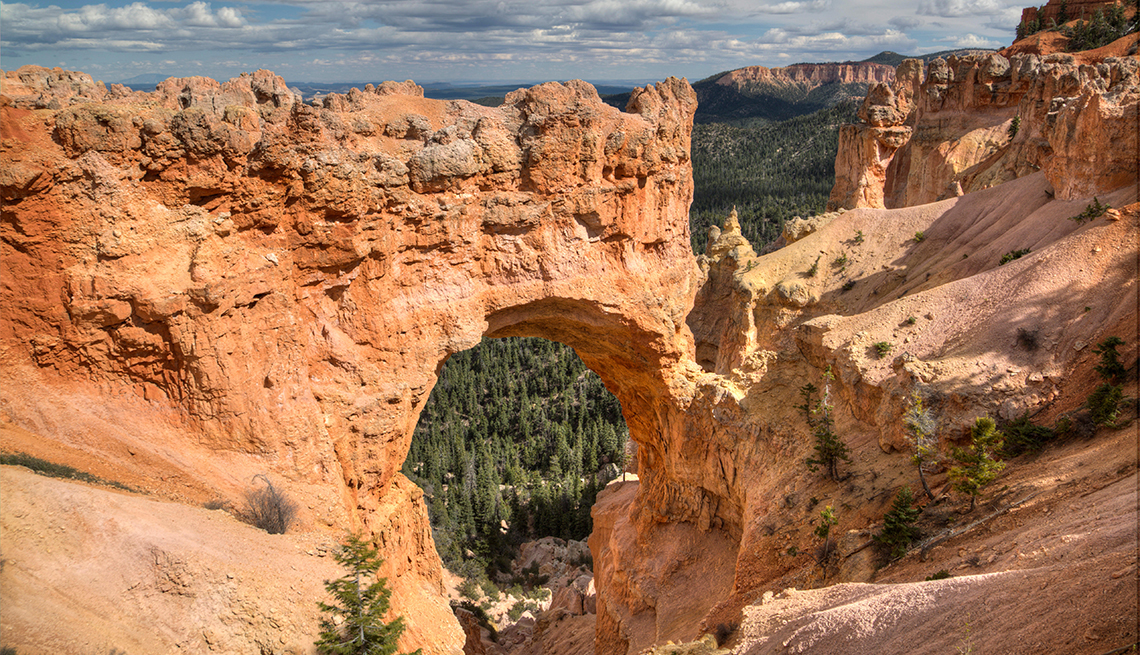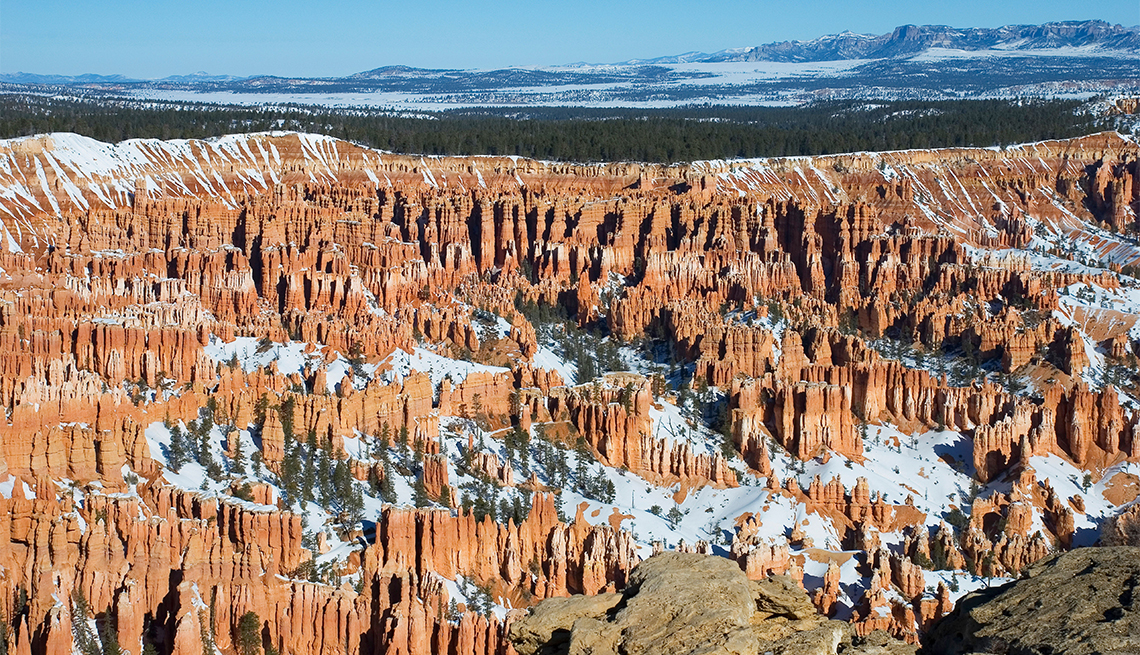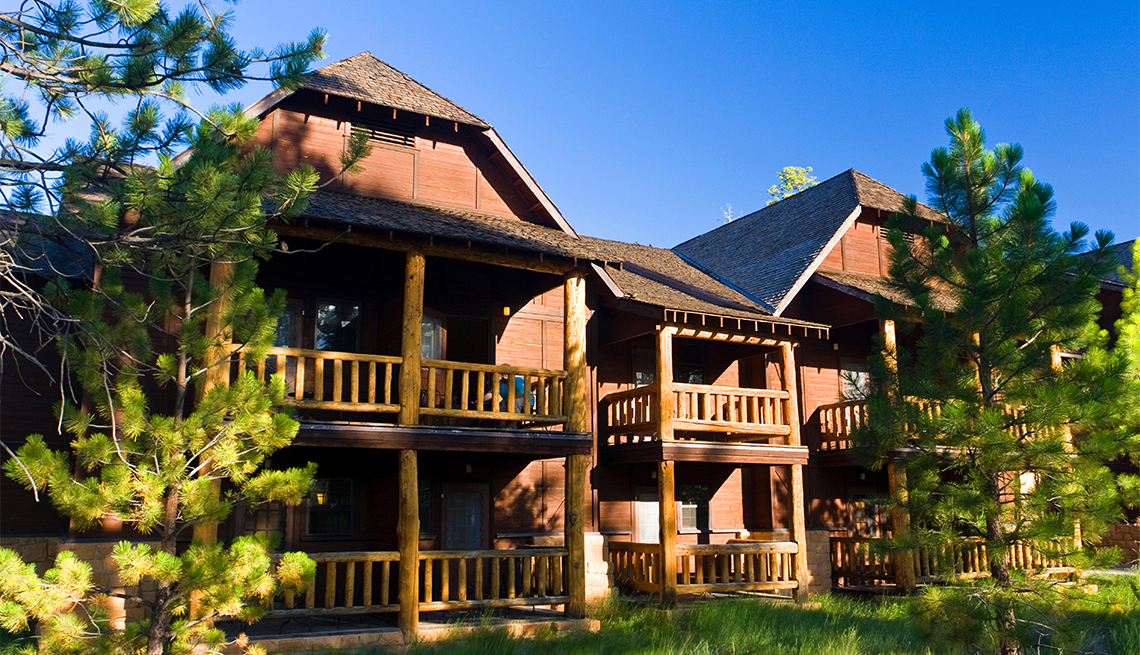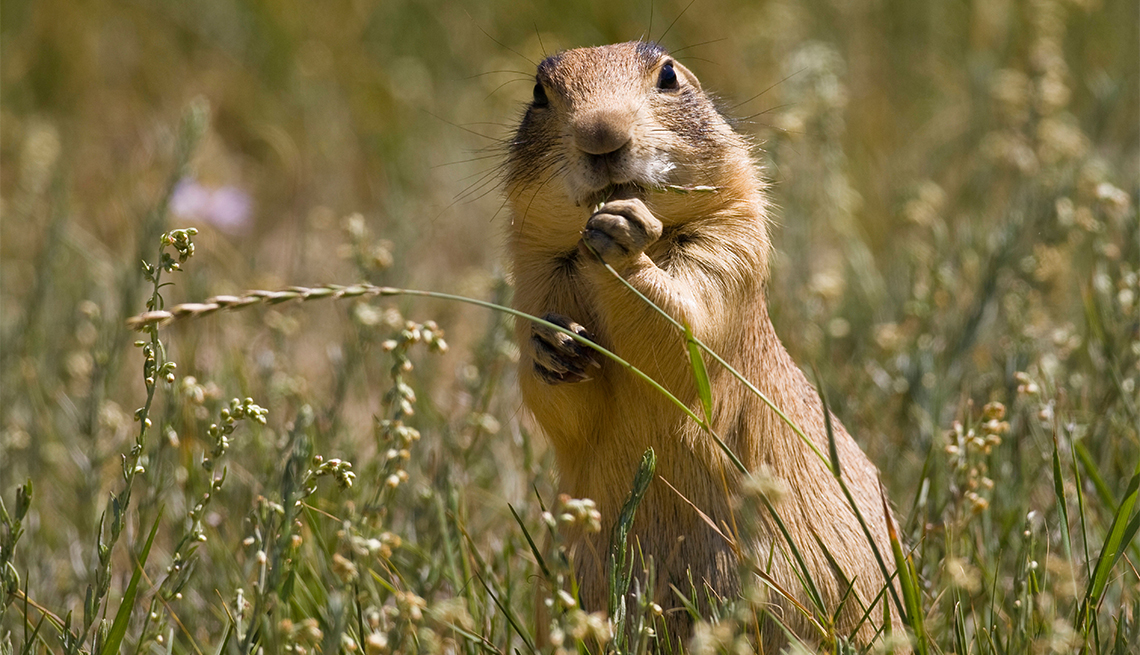AARP's Guide to Bryce Canyon National Park
Find otherworldly hoodoos, red cliffs and magical sunrises in Utah
En español | Some national parks sprawl for millions of acres and encompass wildly diverse terrains; others, such as southern Utah's compact Bryce Canyon National Park (BCNP), do one thing really well. At 56 square miles, BCNP ranks 51st out of 63 national parks by size. But what it lacks in acreage, it makes up for with the world's highest concentration of hoodoos, or totem-pole-like rock columns. (Note that, despite its name, this isn't technically a canyon but instead a series of more than a dozen natural “amphitheaters” carved into a plateau's edge.)
Geologists will tell you that erosion caused the hoodoos. But for a more colorful creation story, we turn to the Indigenous Paiute people, who have lived here since about 1200 CE. According to lore, this area was home to the To-when-an-ung-wa, or Legend People, a prehuman race who mistreated the land and misused its resources. For their misdeeds, the trickster god Coyote punished them by transforming them into stone. Now these spires have funky names that refer to their odd shapes — Thor's Hammer and the Poodle, for example — and they form the basis of nearly every experience within the park: Visitors check off viewpoints that overlook them, hikers weave among them, and photographers jockey for position to shoot them in every type of light, from the warm glow of sunrise to the milky shine of a full moon.
Mormon pioneers first settled the area in the 1850s, and the eventual park's namesake, Scottish immigrant Ebenezer Bryce, reportedly called the mazelike terrain “a hell of a place to lose a cow.” The plan to set this land aside as a national park began in 1915, when U.S. Forest Service Supervisor J.W. Humphrey transferred to the region and immediately became transfixed with the “indescribable beauty that greeted [him].” He sent word back to Washington, D.C., and worked to improve road access, and tourists began visiting from Salt Lake City before the end of the decade.
President Warren G. Harding named the area a national monument in 1923, Congress passed a bill the next year to establish a national park, and it officially earned that designation in 1928. Today, this otherworldly landscape is a must-visit stop on southern Utah's circuit of five national parks, with some 2.6 million people making the trip in 2019.
Best of all, despite the park's dramatic terrain, you don't need to be particularly adventurous to enjoy its greatest spoils. “Bryce Canyon's most popular views are also its most accessible,” says Amanda McCutcheon, the park's chief of visitor services. “Thirteen of its 14 viewpoints have good to very good access for those using wheelchairs or other mobility devices, and the distance from the parking lot to the view is typically less than 500 feet."
Location: Southern Utah, about 270 miles south of Salt Lake City
Acreage: 35,835
Highest point: Rainbow Point, 9,115 feet
Lowest point: Yellow Creek, 6,620 feet
Miles of trails: 60
Main attraction: Viewpoints overlooking the hoodoos
Entry fee: $35 per vehicle; $20 per year or $80 for a lifetime America the Beautiful Pass for people age 62-plus
Best way to see it: By car or free shuttle bus
When to go to avoid crowds: November (if you want lower visitation and a low chance of snow) or February (if you prefer a snowier experience)
Plan your trip
BCNP is a bit of a trek from the nearest major airport, but the drive through the desert gives you a chance to slow down and get on the same wavelength as this almost mystical landscape. The Las Vegas airport sits about 267 miles southwest of the park, while Salt Lake City's is about 273 miles north. SkyWest Airlines operates daily Delta Connection flights from Salt Lake City to Cedar City, about 90 miles west of the park entrance.
The park is laid out along an 18-mile north-south road, with one entrance at the northern end just outside Bryce Canyon City. Your first stop should be the Visitor Center, next to the entrance; inside, pick up maps, stroll through museum exhibits about the park's geology and fauna, shop in the bookstore and get hiking tips from rangers.
BCNP's popularity means it can get crowded during the tourist season, May through September. To reduce congestion and long lines at parking areas, the park runs a shuttle bus that can make your visit much more pleasant. Simply park your car at one of five stops in Bryce Canyon City, hop on the shuttle and let the driver do all the work. The buses typically arrive every 15 minutes, but you can check for real-time updates on brycecanyonshuttle.com.
Many visitors expect southern Utah to be scorching, but due to Bryce Canyon's high elevation — between 6,620 and 9,105 feet above sea level — its weather remains surprisingly moderate. Even in the hottest summer months, temperatures usually top out in the high 70s. In July and August, the rainy season, you might experience an intense afternoon thunderstorm or two. And from December to February, there could be snow — though snow can fall as early as October and as late as May.
"Defining our peak season versus shoulder season is more of an art than a science,” says Ranger Peter Densmore, the park's visual information specialist. “March to October would be considered by many to be the park's peak season right now.” But despite high visitation numbers during that period, it's not difficult to find a bit of solitude. “By setting off on a hike or, say, a bike ride on the shared-use path, you'll find the crowds quickly thin,” Densmore adds.
For smaller crowds, the ranger suggests visiting in February to see the reddish hoodoos dusted with snow, when a hush falls over the park and all you can hear is the crunch of distant boots on powder. When the snowpack surpasses a foot deep, rangers lead snowshoe hikes, even providing the snowshoes and poles — just dress warmly. With the Fairyland and Paria View roads closed to vehicular traffic, they also make for great cross-country skiing paths.
Where to stay and eat
Wake up with the sun and catch the hoodoos in all their morning glory at the Lodge at Bryce Canyon, the park's only hotel, with 114 rooms set across the main building, adjacent motel accommodations and cabins. Opened in 1925, the rustic lodge structure calls to mind Lincoln Logs, complete with a steeply pitched green roof. Inside the cabins, you'll find gas-log fireplaces and lodgepole pine walls, while the lodge and motel rooms are simply furnished with Arts and Crafts–style pieces and custom wool blankets based on colors and patterns used by the Southern Paiute tribe.
You can make a reservation 13 months before your visit, and the property is open seasonally. This year, the cabins close on Oct. 15, the Sunrise Lodge motel rooms and main lodge guest rooms on Nov. 1, and the Sunset Lodge motel rooms on Jan. 2. The various lodging options reopen at different times each spring.
If you prefer camping, the first-come, first-served North Campground just beyond the Visitor Center is open from spring through fall, with 99 campsites set in a lovely pine grove with gently rolling hills. Sunset Campground, about 1.5 miles south of the Visitor Center, features 100 sites west of Sunset Point. Thanks to the popularity of its trailside location, peak-season reservations are recommended each year from May 20 through Oct. 15 and can be booked at recreation.gov. Note that neither campground has showers; both cost $20 nightly for tents or $30 for RVs.
The Visitor Center also issues $5-per-person permits for backcountry camping, with seven campsites located along the 22.9-mile Under-the-Rim Trail and three on the 8.8-mile Riggs Spring Loop Trail. Keep in mind that the elevation change on these trails ranges from 6,800 to 9,115 feet, so plan — and dress — accordingly, based on the season.
Dozens of lodging options in nearby towns can accommodate most traveling styles: cabins (Cottonwood Meadow Lodge in Panguitch), RV parks (Riverside Ranch in Hatch), inns (Bryce Trails Bed and Breakfast in Tropic), dude ranches (Rockin’ R Ranch in Antimony) and even covered-wagon glamping resorts (Whispering Pines Glamping in Alton). For pure convenience, you can't beat the recently renovated 105-year-old Ruby's Inn, now a Best Western Plus property, just outside the park entrance in Bryce Canyon City. Rent one of the hotel's bikes and go exploring in nearby Dave's Hollow or along the park's paved trails, and then refuel on hearty comfort fare at the hotel's family-style Western buffet and steakhouse.
For a proper meal within the park limits, you currently have one option: the restaurant at the lodge, with the seasonal Valhalla Pizzeria & Coffee Shop closed until summer 2022. The restaurant doesn't disappoint, with its cozy stone fireplace and menu of locally inspired favorites such as almond-crusted rainbow trout, elk and white bean chili, and open-faced bison meat-loaf sandwiches.
For a more casual option, the General Store near Sunrise Point and the North Campground sells grab-and-go salads, pizza and sandwiches; you can also stock up on camping supplies, including canned goods, split wood and cooking fuel, in case you want to prepare a meal back at your campsite.
Things to do
Drive to viewpoints: Marvel at the unparalleled vistas from BCNP's 14 official viewpoints, which deliver that perfect photograph for your slideshow or Instagram grid. The park's shuttle bus stops at four of them: Bryce Point, Inspiration Point, Sunrise Point and Sunset Point. Sunset Point, accessed just after mile marker 2, ranks as the most popular, thanks to its proximity to Thor's Hammer, the best-known and most recognizable hoodoo, while Bryce Point (accessed via a road between mile markers 2 and 3) is best viewed early in the morning, when magical sunrises appear to set the hoodoos on fire. The other viewpoints can all be reached by foot or car. Just past mile marker 12, don't miss Natural Bridge, which dazzles with a scene that's pretty enough to be a painting: Think verdant ponderosa pines peeking through a reddish natural arch.
Take a hike: If you have time, go for a hike — you'll find one for every skill level. On the easier end of the spectrum, take in excellent views of the Bryce Amphitheater on the Sunset to Sunrise Trail, a paved one-mile segment of the Rim Trail. Due to the park's terrain, only a half-mile stretch of this portion of the Rim Trail is officially wheelchair-accessible. Alternatively, the hard-surface Bristlecone Loop at the park's southern end can accommodate some wheelchair users with assistance.
Another easy and especially popular (read: crowded) walk, the 0.8-mile Mossy Cave Trail ends at a grotto with icicles in winter and its namesake moss in summer. For a more moderate challenge, opt for the 1.8-mile Queen's Garden Trail, which takes you down into the canyon for a glimpse of a hoodoo that looks remarkably like Queen Victoria.
If you're a hiking pro, set aside about five hours for the 8-mile Fairyland Loop; you'll cut through a ponderosa pine forest and past the ridged China Wall, which stretches along the horizon like its namesake, and the Tower Bridge, which features a precariously freestanding span. Be warned that you'll be navigating a calf-burning elevation change of 1,716 feet (almost exactly as tall as Chicago's Willis Tower).
To maximize the number of hoodoos you can see on one hike, McCutcheon suggests taking advantage of the shuttle bus system to find great one-way routes that start at one bus stop and end at another. For one of her favorite hikes, get off the bus at Bryce Point and then hike down into the amphitheater along the Peek-a-Boo Loop Trail, following the path clockwise. After you view Cathedral Wall, pick up the Queen's Garden Trail to ascend back up to Sunrise Point and the shuttle bus.
See the sights on horseback: Channel your inner cowboy or cowgirl on a guided horseback or mule tour with concessionaire Canyon Trail Rides. From April through October, book two-hour ($75) or three-hour rides ($100) online at canyonrides.com, then meet your guide at the corral between the park's lodge and Sunrise Point. Both routes take you down to the canyon floor; the longer option then traces Peek-a-Boo Loop Trail, whisking you past the famed Wall of Windows, which looks a bit like a fortress dotted with holes from which medieval knights might have fired their arrows and cannons. “To appreciate Bryce Canyon, a visitor really needs to get below the rim by foot or on horseback,” says Crystal Mortensen, of Canyon Trail Rides, “and the horse rides offer a way for someone who physically can't walk up and down the canyon trails to be up close and personal with the rock formations.”
Spot wildlife: A variety of animal species roam these acres, including mule deer, pronghorn, smaller critters such as feisty golden-mantled ground squirrels (they're so prevalent at picnic areas and overlooks that the NPS website calls them “trip-over common"), and the reintroduced Utah prairie dogs, which reside in the roadside meadows near the park entrance. Because of the higher altitude and cold winters, reptiles and amphibians are not as common as you might expect, but keep your eyes peeled for the masters of camouflage, short-horned lizards (or horned toads). And, depending on the season, you can view 175 bird species, including various hummingbirds that flit around thistles and other flowers, from May through July.
Enjoy the park after dark: Named an International Dark Sky Park in 2019, BCNP delivers a coveted trifecta for stargazers: high elevations, pristine air quality and a remote location far from the nearest sources of light pollution. “Most people in the United States living in urban areas don't get to see the Milky Way, but our dark and frequently clear skies and high altitude make viewing the Milky Way a very special experience,” McCutcheon says. The galaxy appears as a hazy band of light stretching across the sky like a rainbow.
If you visit during a full moon, enter the park's lottery for one of the few slots on a two- to three-hour guided nighttime hike. Submit your name between 8 a.m. and 4 p.m. at the Visitor Center and check whether you've been selected between 4 and 4:15 p.m. The moon's glow bounces off the oddly shaped hoodoos, creating an eerie interplay of light and shadows. The park usually offers one of two hikes, depending on ranger staffing: an easier one along the rim, and a harder one that descends into the canyon.
AARP Membership -Join AARP for just $15 for your first year when you enroll in automatic renewal
Join today and save 25% off the standard annual rate. Get instant access to discounts, programs, services, and the information you need to benefit every area of your life.
Gateway towns
Just north of the park entrance, Bryce Canyon City is little more than a cluster of hotels, restaurants and the kitschy Western-themed shops of Old Bryce Town. But it makes for a comfortable hub if you're not staying in the park.
About a 10-minute drive north of the entrance, the road meets up with Utah State Route 12, a National Scenic Byway and All-American Road dotted with towns worth checking out or using as your hub. About 20 miles to the northwest along Route 12 sits Panguitch, with its National Register of Historic Places–designated historic district and abundant opportunities for angling; the town didn't take its name from the South Paiute word for “big fish” for nothing. If you instead turn southeast on 12 and go about 8 miles, you'll reach Tropic, which has welcoming coffee shops and restaurants, while an additional 40 miles will drop you into Escalante, where picturesque slot canyons surround the town.
If you're combining your visit to BCNP with Zion National Park, consider a stay in Kanab, about 75 miles south of Bryce Canyon, near the Arizona border, and a half-hour drive from Zion. Surrounded by sagebrush, sandstone cliffs and abandoned western-genre movie sets, the self-styled “Little Hollywood” is home to several unique lodging options. Best Friends Roadhouse and Mercantile arguably ranks as America's pet-friendliest hotel, with its pet park, dog-walking services, in-room cubbies and snuggling areas, and a shop stocked with treats.
En route
From Las Vegas, the four-hour drive along Interstate 15 takes you through the adventure gateway of St. George, Utah. Adrenaline-pumping thrills include ATVing in Sand Hollow State Park or mountain biking on Gooseberry Mesa, and the area even boasts a burgeoning wine region, with roots dating back to the early Mormon settlers — before they banned sacramental wine. And you should certainly take a detour to Zion, about an hour's drive northeast of St. George, to see its gorgeous namesake canyon.
From Salt Lake City, cross off another of the state's big 5 national parks: Capitol Reef, nicknamed the “Land of the Sleeping Rainbow” by the Navajo because of the riotous colors of its canyon walls, sits about two hours northeast of BCNP near Torrey. Along the four-hour drive south from the capital, don't miss several natural landmarks, including Timpanogos Cave National Monument and Fishlake National Forest, a hot spot for splake and trout fishing.
- |
- Photos
Nicholas DeRenzo is the former executive editor of Hemispheres, the in-flight magazine of United Airlines, and his writing has appeared in Condé Nast Traveler, New York magazine, The New York Times and Wine Enthusiast.

